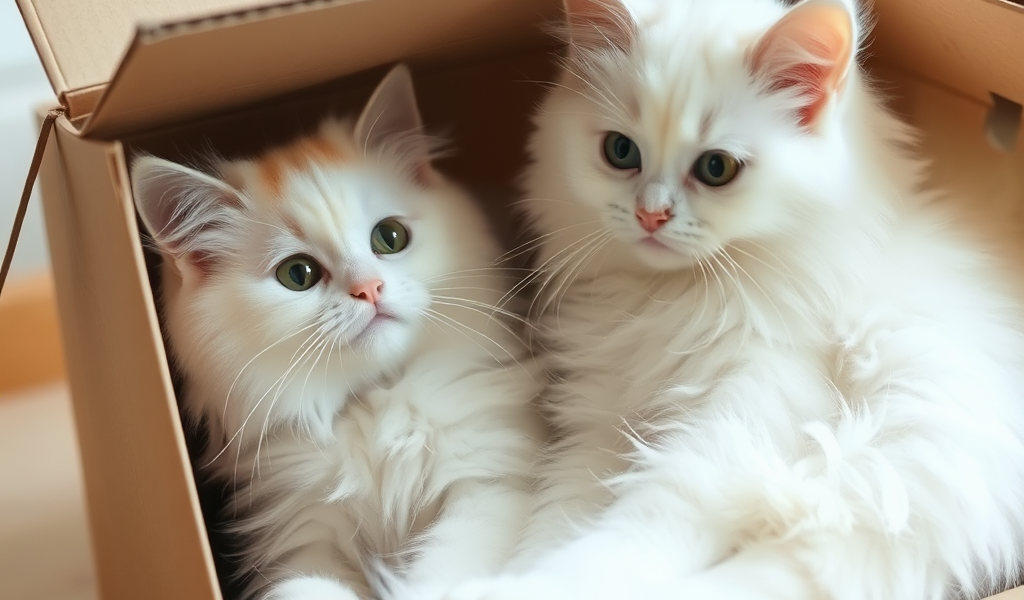Welcoming a new feline friend into your home is an exciting adventure, but it can also come with its own set of challenges, especially when it comes to litter box training. As independent and sometimes unpredictable creatures, cats may not instinctively know where to go when nature calls. However, with the right guidance and a sprinkle of patience, you can turn this essential training into a seamless experience for both you and your furry companion. In this ultimate guide, we’ll explore effective tips and tricks to make litter box training not only manageable but also successful. From choosing the perfect litter box and the best type of litter to understanding your cat’s behavior and preferences, we’ll provide you with all the insights you need to ensure your cat feels comfortable and confident using the litter box. Say goodbye to accidents and hello to a happier, more harmonious home with your beloved pet!

1. Choosing the Right Litter Box and Litter
When it comes to litter box training your cat, selecting the right litter box and litter is crucial for ensuring a smooth and successful experience. First, let’s talk about the litter box itself. You’ll want to choose a box that is spacious enough for your cat to turn around comfortably; it should ideally be one and a half times the length of your cat from nose to tail. Covered boxes can help contain odors and litter scatter, but some cats may feel confined or anxious in them. Therefore, consider an open box if your cat prefers more space and visibility. Look for options with low sides for easy entry, especially for kittens or older cats with mobility issues.
Next, let’s discuss the litter. The type of litter can significantly influence your cat’s willingness to use the box. There are various types available, including clumping, non-clumping, clay, and natural or biodegradable options. Many cats prefer fine-grained litters, as they mimic the texture of sand or soil. Clumping litter is popular because it makes cleaning easier, but some cats might be sensitive to the dust it produces. If your cat is particularly discerning, you may need to experiment with different types or mixes until you find the one that suits them best.
Additionally, consider the scent of the litter. Unscented options are generally more appealing to cats, who have a keen sense of smell and may be put off by strong fragrances. Aim for litter that controls odors without overpowering your furry friend. Lastly, place the litter box in a quiet, accessible area away from loud noises or heavy foot traffic, ensuring your cat feels safe and comfortable when doing their business. Taking the time to choose the right litter box and litter will create a positive environment for your cat and set the foundation for successful litter box training.
2. Setting Up the Perfect Litter Box Location
Setting up the perfect litter box location is a crucial step in ensuring successful litter box training for your cat. The right placement can make all the difference in encouraging your feline friend to use the box consistently. Begin by choosing a quiet, low-traffic area in your home. Cats are naturally cautious creatures, and they prefer a sense of privacy when it comes to their bathroom habits. Avoid placing the litter box near loud appliances, busy hallways, or areas where they may feel vulnerable, such as near doors or windows.
Next, consider accessibility. The litter box should be easily reachable, especially for kittens or older cats that may have mobility issues. If your home has multiple levels, it’s advisable to provide a litter box on each floor to prevent any accidents. Additionally, make sure the box is placed away from their food and water bowls, as cats prefer to keep their eating and bathroom areas separate.
Once you’ve chosen the perfect spot, ensure that the litter box itself is inviting. A clean, spacious box with low sides is ideal for easy entry and exit. Keep in mind that some cats may prefer covered boxes for added privacy, while others may feel trapped in them. It may take some experimentation to find what your cat prefers.
Finally, don’t forget to monitor the litter box for cleanliness. Cats are fastidious animals, and a dirty box can quickly deter them from using it. Regular scooping and a complete change of litter weekly will go a long way in keeping your cat comfortable and happy with their designated bathroom area. By thoughtfully setting up the litter box location, you’re laying the groundwork for a successful training experience that promotes good habits and a harmonious home.

3. Understanding Your Cat’s Behavior and Preferences
Understanding your cat’s behavior and preferences is crucial for successful litter box training. Cats are creatures of habit, and their instincts play a significant role in how they interact with their environment, including their bathroom habits. One of the first things to consider is the natural instinct of cats to bury their waste. In the wild, this behavior helps them avoid detection by predators, making it essential to provide them with a litter box that mimics this instinctive need.
Pay attention to your cat’s body language and preferences when it comes to the type of litter used. Some cats may prefer clumping litter that allows them to bury their waste easily, while others might favor non-clumping varieties. Experimenting with different textures and scents can help you pinpoint what your cat finds most comfortable. For instance, some cats may shy away from overly fragrant litters, opting instead for unscented options.
Notably, the positioning of the litter box is of paramount importance. Cats are territorial and like to choose their spots; placing the box in a quiet, low-traffic area will encourage them to use it regularly. Additionally, consider providing multiple litter boxes if you have several cats, as some may prefer to have their own space.
Lastly, observe your cat’s behavior after meals or playtime. Cats often need to relieve themselves shortly after eating, so providing easy access to the litter box during these times can reinforce positive habits. By understanding your cat’s preferences and behaviors, you can create a comfortable and inviting environment that facilitates successful litter box training, ensuring both you and your feline friend are happy and stress-free.
4. Training Techniques for Litter Box Success
Training your cat to use the litter box can be a straightforward process with the right techniques in place. The first step in ensuring litter box success is to choose the right litter box and litter. Opt for a box that is easily accessible and appropriately sized for your cat. Kittens may prefer shallow boxes for easy entry, while larger cats may require a spacious option. When it comes to litter, test out different types—clumping, non-clumping, and biodegradable options—to see which one your cat prefers.
Once you have the right setup, place the litter box in a quiet, low-traffic area of your home to help your cat feel safe and comfortable. To encourage your cat to use the box, gently place them in it after meals or playtime, as these are natural times when they may need to relieve themselves. Observe your cat’s behavior, and if they show signs of needing to go, guide them back to the box.
Positive reinforcement is key to successful training. Whenever your cat uses the litter box, reward them with praise or a small treat to reinforce the behavior. Avoid scolding or punishing your cat for accidents outside the box, as this can create anxiety and hinder the training process. Instead, clean any accidents thoroughly to eliminate lingering odors that may attract your cat to the same spot again.
If your cat initially resists using the litter box, consider experimenting with different litter types or box styles, such as covered versus uncovered options. Patience and consistency are crucial; your cat may take some time to adjust to their new routine. By employing these training techniques and being attentive to your cat’s needs, you’ll set the stage for successful litter box habits that will keep both you and your feline friend happy.
5. Common Challenges and How to Overcome Them
When it comes to litter box training your cat, challenges are a natural part of the process. Understanding these common hurdles and knowing how to overcome them can make the journey smoother for both you and your feline friend.
1. Refusal to Use the Litter Box: One of the most frequent issues cat owners face is their pets ignoring the litter box altogether. This can stem from a variety of reasons, including an aversion to the litter type, box placement, or even cleanliness. To tackle this, experiment with different litter materials—clumping, non-clumping, clay, or natural options—to find what your cat prefers. Additionally, ensure the litter box is located in a quiet, low-traffic area where your cat feels safe to do their business. Regularly scooping and cleaning the box will also encourage your cat to use it consistently.
2. Accidents Outside the Box: If your cat has been trained but begins to have accidents outside the litter box, it might indicate underlying medical issues, stress, or territorial behavior. Always consult your veterinarian first to rule out health problems. If health isn’t the issue, reassess environmental factors such as changes in your home, new pets, or even the litter box’s location. Offering multiple litter boxes, especially in multi-cat households, can help alleviate any territorial disputes.
3. Litter Box Resistance: Some cats may be hesitant to enter their litter box, often due to its design or size. If the box is too tall or enclosed, consider switching to a low-entry, open box that is easier for your cat to navigate. Furthermore, ensure that the box is spacious enough for your cat to turn around comfortably—especially in larger breeds. Creating a positive association with the box, such as placing treats nearby or even inside, can also help encourage your cat to explore and use it willingly.
4. Overly Aggressive Scratching: Some cats may exhibit excessive digging or scratching in the litter, which can lead to litter being scattered everywhere. To mitigate this, consider investing in a litter mat to catch stray bits, or opt for heavier litter types that are less likely to be kicked out of the box. Additionally, providing your cat with appropriate scratching posts can help satisfy their natural instincts without turning your home into a litter-filled landscape.
5. Behavioral Changes: If your cat suddenly stops using the litter box after being consistent, it could be a sign of stress or anxiety. Changes in household dynamics, such as moving or the introduction of new family members, can disrupt your cat’s routine. Creating a calm environment and offering additional comfort through toys or hiding spots can help ease their anxiety. Be patient and give your cat time to adjust to the changes while providing reassurance through gentle interactions.
No two cats are alike, so one method or approach may not be efficient when repeated over different pets. By staying observant and adapting your approach to your cat’s specific needs, you can successfully navigate these challenges and ensure a positive litter box experience for your furry companion. With patience and persistence, you’ll create a harmonious relationship with your cat, making the training process a rewarding journey for both of you.

6. Maintaining a Clean and Inviting Litter Box Environment
Maintaining a clean and inviting litter box environment is crucial for successful litter box training and for keeping your feline friend happy and healthy. Cats are naturally fastidious creatures, and they prefer a tidy space to do their business. A dirty litter box can lead to aversions and accidents outside the box, so regular maintenance is key.
Start by choosing the right litter box size and type; it should be spacious enough for your cat to move around comfortably. Covered boxes can offer privacy but ensure proper ventilation to prevent odors from building up. Once you have the right box, aim to scoop it daily. Remove clumps and waste promptly to keep the litter fresh and odor-free. A general rule of thumb is to completely change the litter every 1-2 weeks, depending on the type of litter used and the number of cats in your household.
Cleaning the box itself is just as important. Use mild soap and warm water to scrub the litter box, avoiding harsh chemicals that could leave residues harmful to your cat. After washing, rinse thoroughly and dry before adding fresh litter.
Additionally, consider the location of the litter box. You should consider placing it in a low-traffic area and quiet space where your cat feels comfortable. Keep it away from their food and water bowls, as cats prefer separation in their environments. Lastly, make sure to provide multiple litter boxes if you have more than one cat, as this prevents territorial disputes and ensures everyone has access to a clean space.
By committing to these maintenance practices, you create an inviting environment that encourages your cat to use the litter box consistently, fostering a positive behavior that benefits both you and your furry companion.
In conclusion, mastering litter box training for your feline friend doesn’t have to be a daunting task. With the right approach, patience, and understanding of your cat’s unique behaviors, you can create a seamless and stress-free experience for both of you. By implementing the tips and tricks outlined in this ultimate guide, you’ll not only promote good habits but also strengthen the bond between you and your pet. Remember, each cat is different, so tailor your methods to suit your furry companion’s needs. Thank you for joining us on this journey to litter box training success! For more insights and resources on caring for your beloved pets, be sure to explore Blogger for a wealth of information. Happy training!


